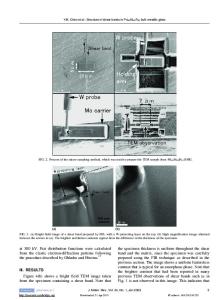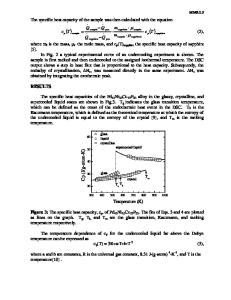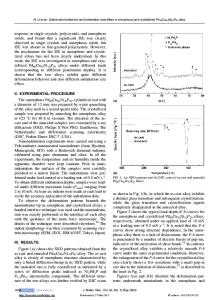Plastic deformation and mechanical softening of Pd 40 Cu 30 Ni 10 P 20 bulk metallic glass during nanoindentation
- PDF / 401,507 Bytes
- 7 Pages / 612 x 792 pts (letter) Page_size
- 4 Downloads / 354 Views
. Alcalá, S. Mato, and A. Gebert IFW Dresden, Institute of Metallic Materials, D-01171, Dresden, Germany
J. Eckertb) Physical Metallurgy Division, Department of Materials and Geo-Sciences, Darmstadt University of Technology, D-64287 Darmstadt, Germany
M.D. Baró Departament de Física, Facultat de Ciències, Edifici Cc, Universitat Autònoma Barcelona, 08193 Bellaterra, Barcelona, Spain (Received 22 March 2005; accepted 28 June 2005)
Nanoindentation tests of Pd40Cu30Ni10P20 bulk metallic glass were performed over a wide range of indentation rates (from 0.04 up to 6.4 mN s−1) under the standard load control mode. New results using the feedback displacement control mode are also presented. The dependence of the pop-in formation on the loading rate is investigated. Variations in hardness and reduced elastic modulus as a function of the indentation rate are observed. A softening effect occurs when increasing the loading rate. This is explained by the differences in plastic deformation achieved at different indentation rates. The displacement control mode was used to avoid the shear localization of the free volume, leading to the almost complete absence of pop-ins along the loading curve. The obtained results suggest that plastic flow in bulk metallic glasses is governed by the rate of creation of free volume, which depends on the strain rate and its localization into shear bands.
I. INTRODUCTION
The interest in metallic glasses has increased during the last years due to the discovery of several multicomponent systems with high glass-forming ability, which allows obtaining fully bulk amorphous alloys at a cooling rate lower than 102 K/s.1,2 Some of these bulk metallic glasses (BMGs) exhibit outstanding mechanical properties, such as low density, high strength, high fracture toughness,3–6 or good corrosion and wear resistance,7 which make them suitable candidates for application as structural materials. However, metallic glasses typically exhibit little global plasticity before fracture at room
a)
Address all correspondence to this author. e-mail: [email protected] b) This author was an editor of this journal during the review and decision stage. For the JMR policy on review and publication of manuscripts authored by editors, please refer to http://www. mrs.org/publications/jmr/policy.html. DOI: 10.1557/JMR.2005.0331 J. Mater. Res., Vol. 20, No. 10, Oct 2005
http://journals.cambridge.org
Downloaded: 17 Mar 2015
temperature.8–10 This has been explained as a consequence of the fact that their plastic deformation is governed by strain localization in shear bands.11 Spaepen suggested that shear localization is the result of the dilatation that must accompany high-rate shear deformation of the dense random close-packed structure present in the glass.11 The increase in free volume due to such dilatation causes a precipitous drop in the viscosity, which in turn tends to localize the flow into shear bands. Recent detailed high-resolution transmission electron microscopy (HRTEM) investigations on the shear bands in a m
Data Loading...











